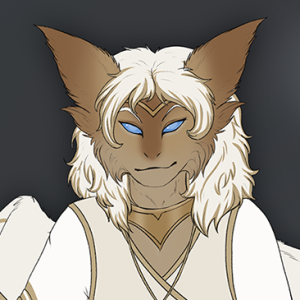Il'hune
An extinct species of tall, elegant winged giants. Many Li'uhn attribute them as their creators. They are mostly wrong in this; they were simply two species within the same genus, and before they became sophints, Li'uhn were commonly kept as pets, with several 'breeds' fancied over time. The Il'hune uplifted the Li'uhn, allowing them to gain sapience after their demise, but the Il'hune did not create them. The Li'uhn were actually a major domesticated species before the Il'hune died out. They gained their sapience after, becoming the next main sapient in their region.
There are six of them left sealed in an oasis under a curse of immortality. There will only ever be six of them, and they are unable to leave the oasis temple they have been tasked to protect after their war destroyed their world and civilization and they are completely incapable of reproducing as part of the curse. Each of the Six Ancestors had a major part in the war that destroyed their world and caused their species to go extinct. Their imprisonment is a punishment, to make them attone for their wrongdoings, and protect the remains of the being they killed to use for their own purposes. They take this very seriously, and do their best to guide the li'uhn down a better path. Each of the Six has deep regrets over what they did in the past. Especially with none of their own kind left anywhere else in the world.
One of them tried to break the spell, in a way, and create a new il'hune, but she died in the process. The resulting il'hune that replaced her, Tahti, was outcasted. Kaaru took him under his wing and is kind to the young Il'hune. Tahti is an adult, but he's so much younger than the rest that they all just think of him as a kid. Despite being almost 200 years old.
The li'uhn are held back from the level of advancement the il'hune had due to the il'hune having used up the world's resources for their own purposes, though the li'uhn don't seem to mind too much. They're nomadic creatures, constantly on the move.
The Six are Kaaru, Tahti, Rama, Vahanu, Haolani and Dayalu.
Click on their names to take you to their profiles on Realms-Between. This will give you more information about each of the Six, their dynamics with eachother, and their part in the war that destroyed their planet.
Basic Information Hide
Il'hune were tall and powerful beings, natural workers of magic. They were incredibly advanced, and had exhausted their world's resources and gone to war over the last of what the world had to offer.
They were true giants, standing around 15 feet tall. They were omnivores, though require more meat than vegitation. They had sharp teeth and sharp retractible claws. They look very similar to Li'uhn, just bigger. They created the smaller beings in their own image.
They were generally proud and fierce, and could be highly territorial and warlike when resources ran thin. They tried to play god, using a god they killed to create life in their own image, and possible livestock and plants for them to use. The last hundred years their species existed was marked with suffering and pain, with no way to raise food, their technology failing around them, and them dying out until there were none left. Only six remain, under a curse of immortality and sealed away in the central Oasis that was once seen as a holy spot to them.
Even with their advancement, il'hune were very ceremonial and traditional and generally held close to their kind's religous beliefs. They preferred clothing in cream, white and gold, and those with deep golden fur were seen as more attractive. Their blue eyes were striking against ther golden faces. They often wore ceremonial robes when on holy ground, or in the Oasis that was seen as a center of peace before it became the very last place with natural resources and the center of the final, bitter and terrible fighting that resulted in the extinction of the race.
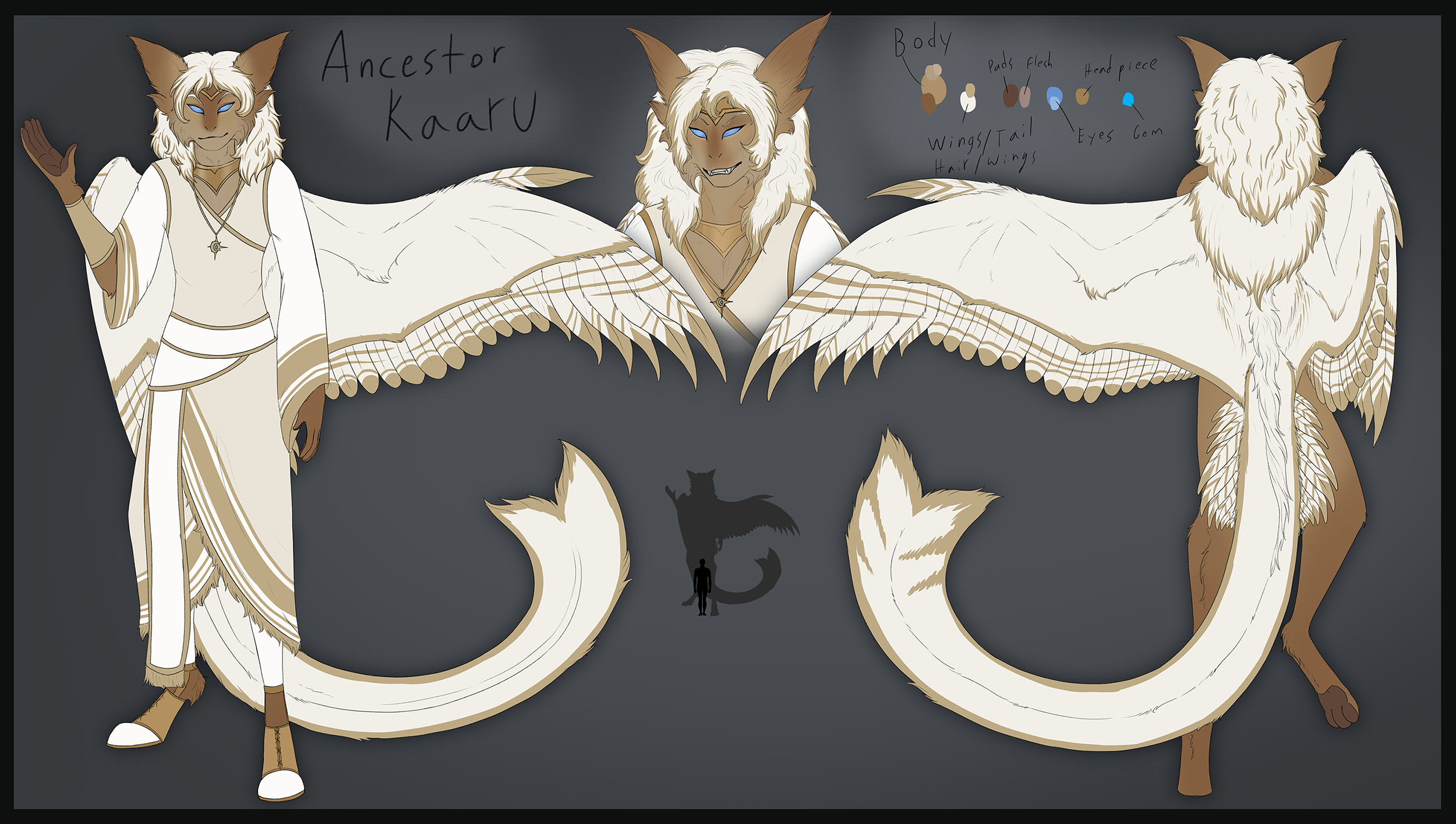
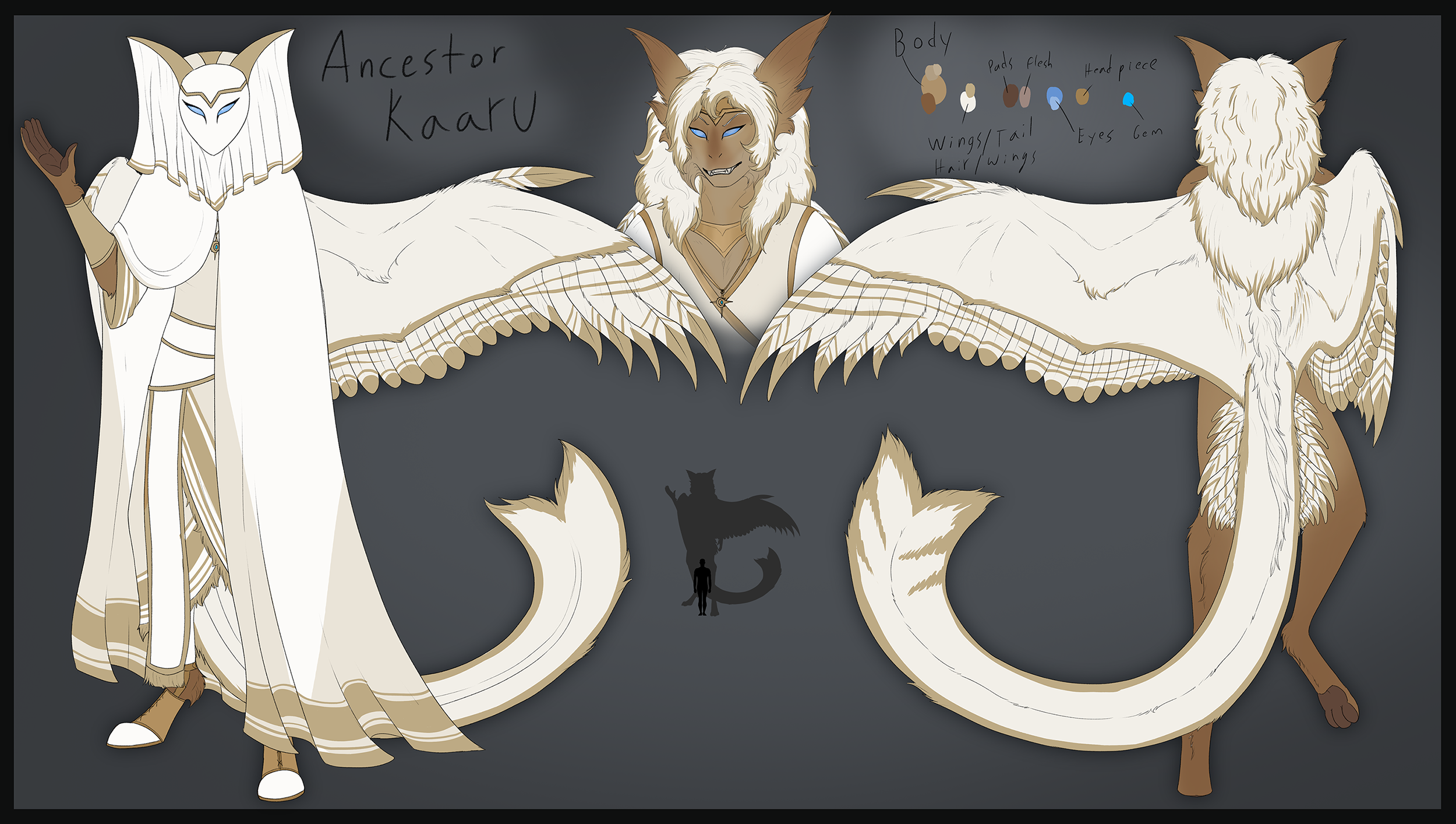
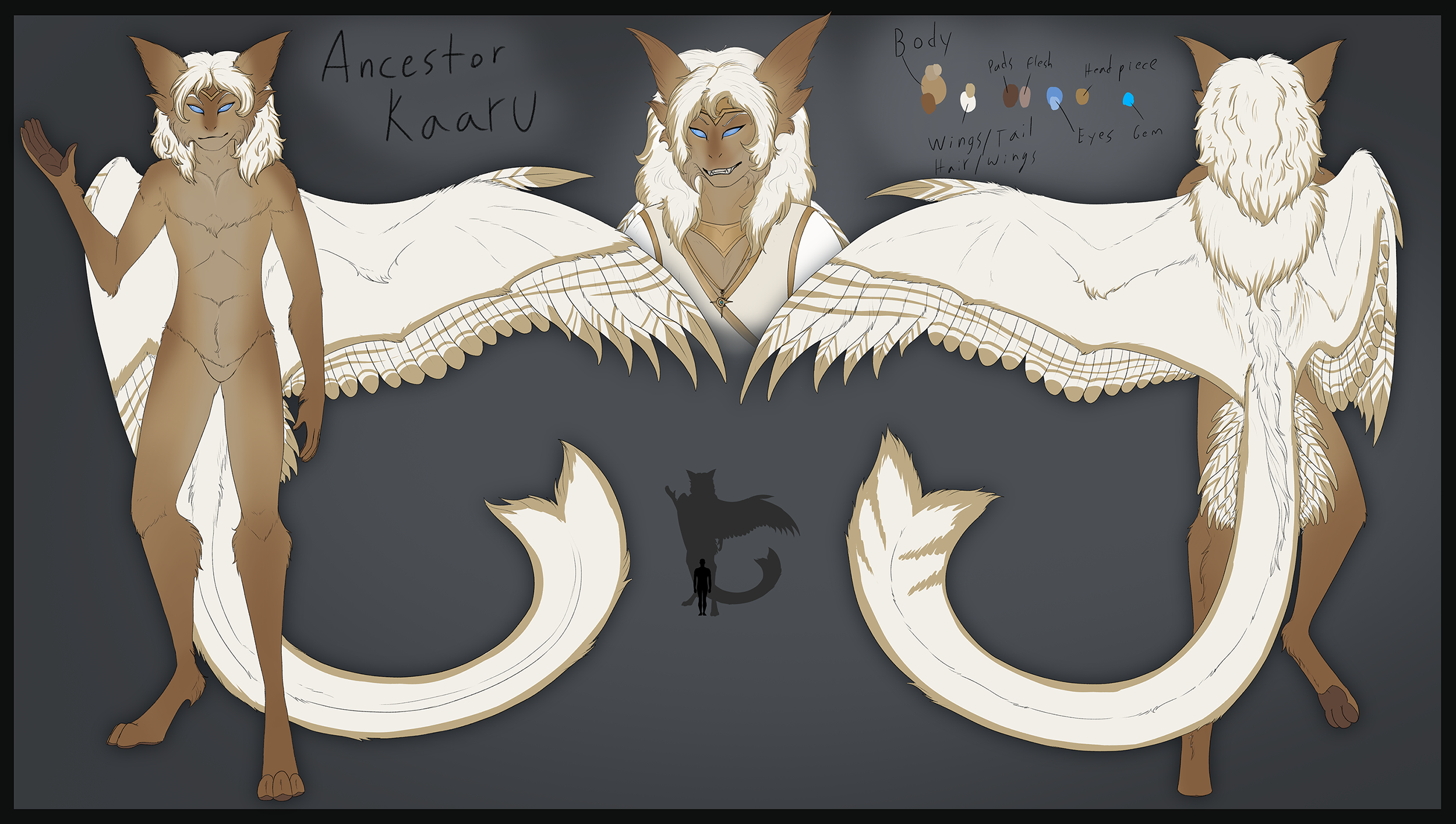
Lore and History Show
Il'hune ruled their world for thousands and thousands of years. They could be seen in every corner, even in great cities under the ocean with water held back by great glass domes and magic. Their cities were huge and expansive with beautiful architecture. Built tough, many of their cities are still standing even thousands of years later, even if reclaimed by nature and ruined in places. Some of their remains can be found, mummified and dried out, deep under the sand where they fell and were buried, though those that were not buried have long since faded to dust in the years. All that remains is stone tablets, their buildings, murals, and various other signs that can be seen throughout the world as well as old and broken down war machines and the remains of factories and other various buildings... and mysterious robed beings made of cloth that communicate with chirps and fly gracefully, ever drawn to a great mountain in the distance. The Li'uhn live among their ruins. They have some vague cultural memory from thousands of years ago, but most Li'uhn know nothing about their predecessors.
Their history was rich and expansive, many important figures, battles, advancements... Nations and diplomacy, millions, perhaps even billions, of them living and thriving in their world. But none of that remains. The last great event of note is the war that brought about their end thousands of years ago, the one that resulted in the end of their time on their world and for the li'uhn to inherit the war-torn world and take over.
During the time that the Il'hune ruled the world, Li'uhn existed alongside them. Li'uhn were smaller, less powerful, and tended to wander the more remote areas. They were not as advanced as the Il'hune. They were starting to gain intelligence, but weren't quite sapient yet. They were starting to develop rudamentary language, akin to something like a dolphin, elephant or chimpanzee. They share a common acestor with the Il'hune, thus some appearance was similar. But it was like the similarity between humans and other great apes.
A major difference, however, is that Li'uhn were docile and social, and as such were perfect for domestication. Some Il'hune kept them as pets and trained them, there were even some variants that rose from selective breeding. They did not gain sapience until after the Il'hune died out. They were getting close to that point, intelligent enough that keeping them as pets was no longer common practice among the Il'hune, but they didn't become sophonts until at least a few hundred years after they inherited the world.
Each of the Six sealed in the Oasis, the very last of their kind that will ever exist, was integral to the war and the destriction of their world. Being sealed is a punishment, put in place by the gods they once worshipped. The barrier is powered by these gods, who lie dormant deep beneath the Oasis, beyond the barrier where the Six can not get to them.
The Six take their punishment very seriously, even if they are tired of living on and on for thousands of years. They now see the li'uhn as living beings every bit as much as them. With many generations passing since the original li'uhn, even stories of the il'hune's warring have faded to mythology and folklore.
Social Habits and Temperament Hide
Il'hune were incredibly territorial and fierce. Warlike and proud, but very traditional and religous. They took great pride in ceremony and beauty, loving white and gold more than any other color combination.
Some examples of Il'hune clothing: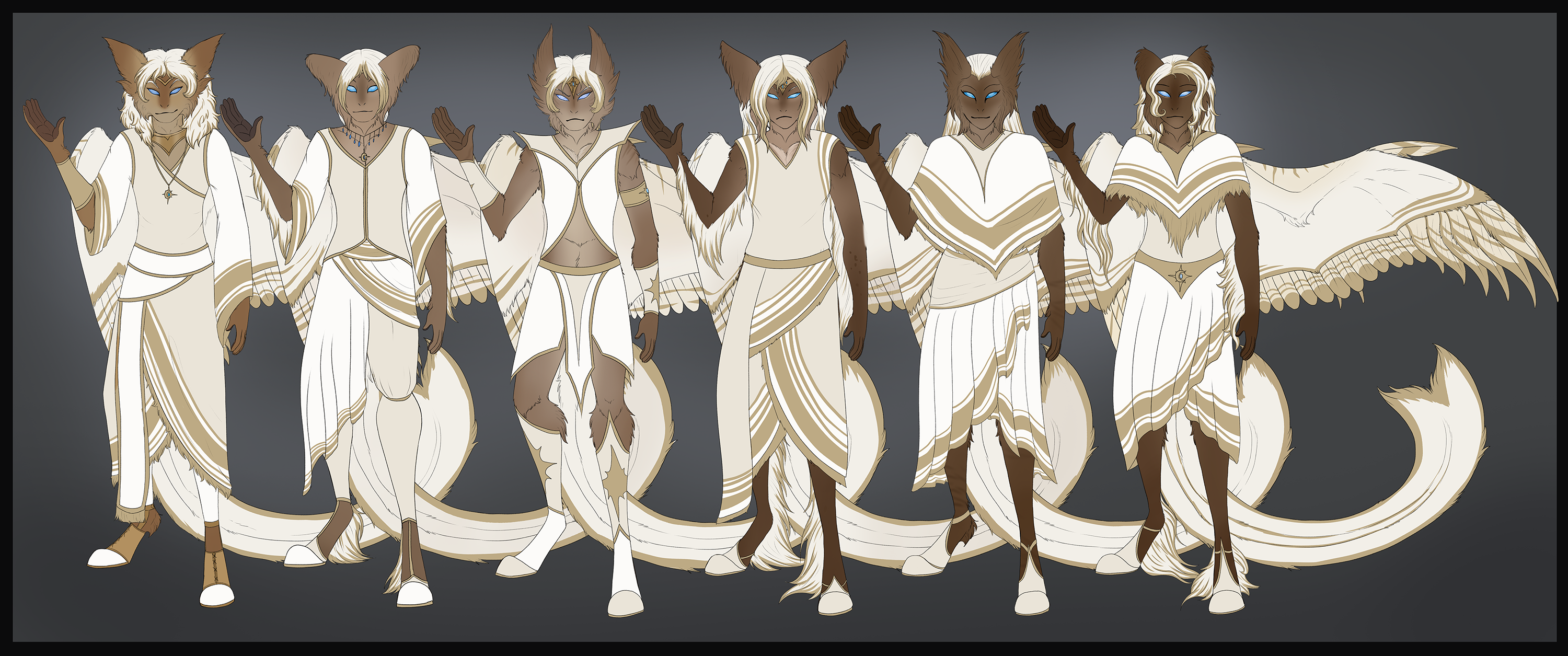
They were loyal to their family, gods, and nations. They fought fiercely to protect what they saw as theirs. Il'hune do best when in small groups, about the size of a lion pride, with one dominant Il'hune, often masculine, and around 8 to 10 other Il'hune and their young. Young Il'hune would generally leave the family group they were born to once they came of age, and either start their own family group, take over another, or join them if they weren't particularly dominant. Il'hune were, in general, fairly restless, wandering throughout the day and returning to their home at night. This nature made the large cities they inhabited stressful, which often caused tension and fighting and the nations working on expanding their borders to make room for their citizens and make room for more resources.
As their resources ran out and the il'hune struggled to survive, the stronger Il'hune would live on while the weaker ones died. They became jaded to the deaths eventually, simply trying to survive.
Il'hune were social, but they did the best in smaller groups.
Their voices were low and powerful and resonant, comparable in a sense to a large bell, the energy pulse they produced strong, able to be picked up from far away. Like the li'uhn they created, Il'hune were very fond of song and dance and music. Song and dance was a huge part of their culture, often accompanied by aerial displays with their wings and natural magic helping them rise up further into the air.
Each Il'hune's ceremonial robes were the same, but their mask was made for them directly upon coming of age, unique to their face shape and personality.
The Six with examples of the Ceremonial mask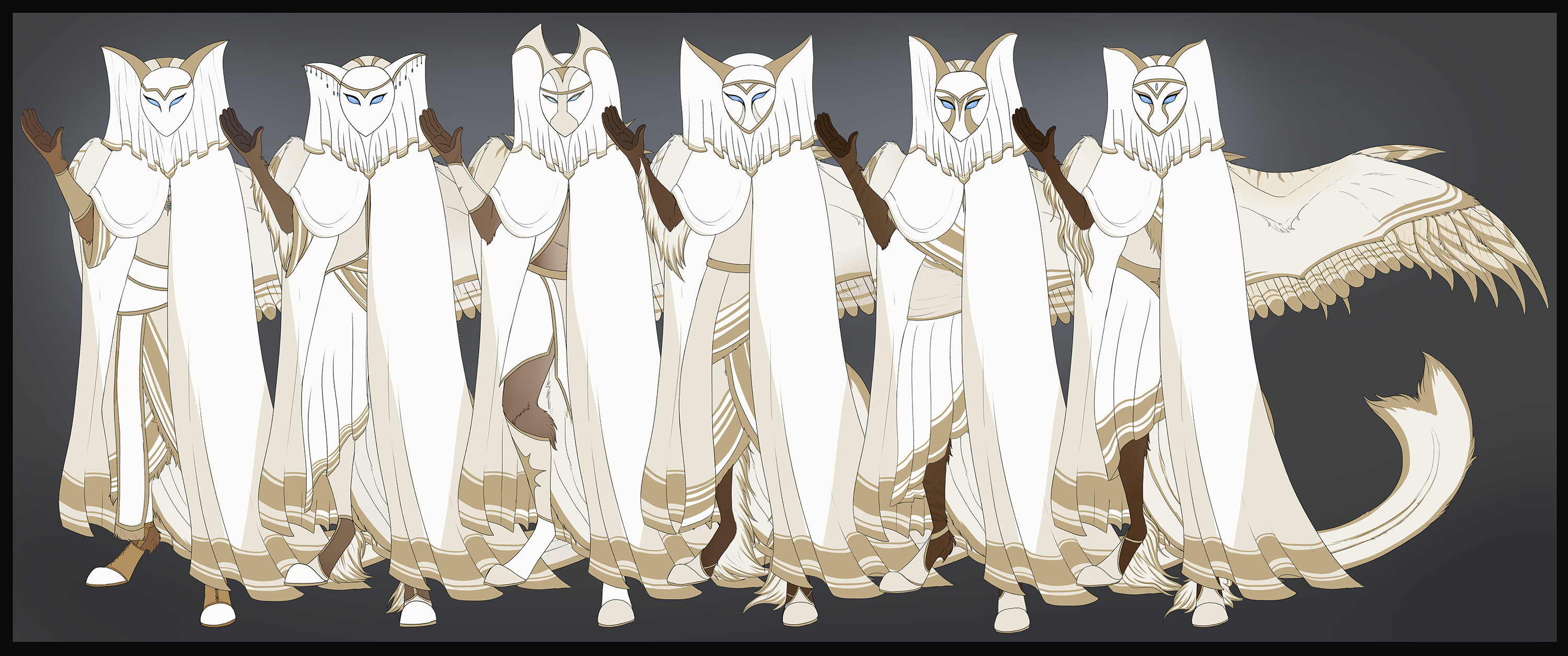
Family members were not territorial towards eachother, so many families would often have their own territories in the wider territories owned by the family group in general. This, in fact, was what caused Il'hune to gather into nations in the first place, family groups growing, turning into villages, then into towns, then cities... then entire nations. Il'hune were very community and family driven, and would fight fiercely to protect and keep their loved ones alive.
Anatomy and Physiology Hide
Il'hune were carnivore-leaning omnivores. Like humans, the sorts of plants they could eat and what they could get out of these plants was limited. They needed more animal protien and supplemented with plants for vitamins, minerals, and fiber. Their sharp teeth could grip and bite and slice through meat with ease, their claws long and curved and capable of gripping and clinging.
They stood an average of 15 feet tall, though were surprisingly light and slender for their great size. They couldn't fly under the might of their own wings, so used the natural energy their kind had in their core to power their wings. This would stir up the air beneath them and allow them to fly.
Il'hune traits and features were similar to the traits and features found on various li'uhn, though their coloration and bodytypes were a lot less varied.
There are only six that remain, but they have a variety of the traits Il'hune were able to have. They are the last and only examples of their species.
Il'hune were generally quite slender, due to their wings and being generally active, flying about from place to place. Being slender and light made it easier for them to take off using their natural magic, stay airborn for longer, and get further faster. Overweight il'hune were quite rare, especially towards the end of their race when they were wasting away from famine and starvation.
Some examples if Il'hune traits and coloration: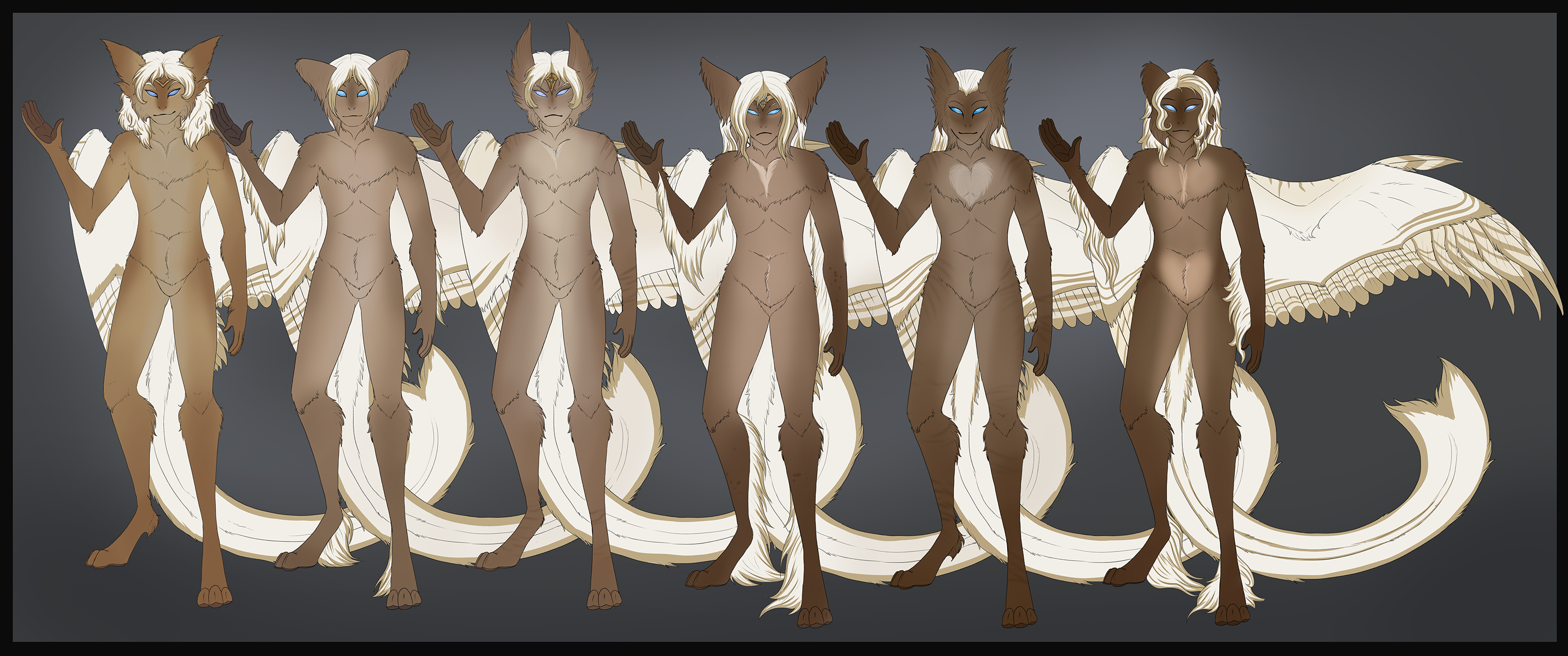
Reproduction and Life Cycle Hide
Il'hune lived, naturally, around 300 years. The same amount of time the Li'uhn live on average nowadays.
Il'hune are pouched mammalians like their Li'uhn cousins. They were not marsupials, but rather evolved the pouch convergently. Their ancestors were nomadic, flying from oasis to oasis, much like Li'uhn do today, and they would carry their young in their pouches with them.
Il'hune went into season mid to late Spring, and would remain pregant for roughly two years. The newborn would be tiny, hairless and featherless with closed eyes. It would be placed in the pouch where it'd spend the first 8 months nursing and growing, at which point it'd start to poke its head out of the pouch, and even begin to come out and try to learn how to fly. At this age, they'd be covered in thick, fluffy down, with their feathers just starting to come in. They'd outgrow the pouch and be weaned by their third year.
Il'hune reached maturity at roughly the same rate as humans, with their pouches not developing until puberty was complete.
Elder Il'hune were seen as culturally significant. They were storytellers, keepers of tradition, guides to the younger generations. The golden markings would fade out as they aged, and they'd grey and whiten around the snout, chest, and limbs, eventually dulling and losing most of their colors as they reached the end of their life.
Young Il'hune stuck close to their parents, though as they reached teenagehood, they became restless and would wander out further, until adulthood had them often wandering off to start their own lives.
Mutations and Variations Hide
Il'hune were mostly golden colored, ranging into brown with darker limbs and faces. They had different Frill types, different feather types, different mane types, and similar.
There are some records of a variant that had fur as black as shadow with golden wings, manes, and tails.
Not many records remain, however, of the various mutations and variations they had.
Other Information Hide
The Il'hune died out thousands of years ago, very little records of them remain.
There are scrolls, murals, and libraries preserved by ancient magic that can still be found to this day, though this is only snippets of what they once were, enough to make the Li'uhn that stumble across them curious. Many Li'uhn have no idea what these Il'hune are, only that depictions show a lot of similarities so they have started calling them the Ancestors, and some even see them as ancient fallen gods.

